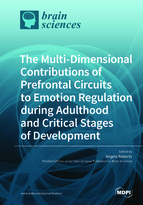The Multi-Dimensional Contributions of Prefrontal Circuits to Emotion Regulation during Adulthood and Critical Stages of Development
A special issue of Brain Sciences (ISSN 2076-3425). This special issue belongs to the section "Systems Neuroscience".
Deadline for manuscript submissions: closed (30 April 2019) | Viewed by 100960
Special Issue Editor
Special Issue Information
Dear Colleagues,
The prefrontal cortex (PFC) plays a pivotal role in regulating our emotions as shown by the marked alterations in activity within prefrontal circuits that accompany mood and anxiety disorders. The importance of ventromedial regions in emotion regulation, including the ventral sector of the medial PFC, the medial sector of the orbital cortex and subgenual cingulate cortex, have been recognized for a long time. However, it is increasingly apparent that lateral and dorsal regions of the PFC, as well as neighbouring dorsal anterior cingulate cortex, also play a role. Defining the underlying psychological mechanisms by which these functionally distinct regions modulate positive and negative emotions and the nature and extent of their interactions, is a critical step towards better stratification of the symptoms of mood and anxiety disorders, that will ultimately lead to more effective, individualised treatment strategies. Since many disorders of emotion regulation have their onset during childhood and adolescence it is also important to extend our understanding of these prefrontal circuits in development. Specifically, to determine whether they exhibit differential sensitivity to perturbations by known risk factors e.g. stress and inflammation, at distinct developmental epochs. This special issue aims to bring together the most recent research in humans and other animals that addresses these important issues and in doing so, to highlight the value of the translational approach.
Prof. Angela RobertsGuest Editor
Manuscript Submission Information
Manuscripts should be submitted online at www.mdpi.com by registering and logging in to this website. Once you are registered, click here to go to the submission form. Manuscripts can be submitted until the deadline. All submissions that pass pre-check are peer-reviewed. Accepted papers will be published continuously in the journal (as soon as accepted) and will be listed together on the special issue website. Research articles, review articles as well as short communications are invited. For planned papers, a title and short abstract (about 100 words) can be sent to the Editorial Office for announcement on this website.
Submitted manuscripts should not have been published previously, nor be under consideration for publication elsewhere (except conference proceedings papers). All manuscripts are thoroughly refereed through a single-blind peer-review process. A guide for authors and other relevant information for submission of manuscripts is available on the Instructions for Authors page. Brain Sciences is an international peer-reviewed open access monthly journal published by MDPI.
Please visit the Instructions for Authors page before submitting a manuscript. The Article Processing Charge (APC) for publication in this open access journal is 2200 CHF (Swiss Francs). Submitted papers should be well formatted and use good English. Authors may use MDPI's English editing service prior to publication or during author revisions.
Keywords
- Emotion regulation
- Prefrontal circuits
- Translational Neuroscience
- Developmental models of psychiatric symptoms







